SWK2108 Case Study: Drug and Substance Abuse During Leavers' Week
VerifiedAdded on 2023/03/17
|11
|2854
|59
Case Study
AI Summary
This case study examines the issue of drug and substance abuse among students during Leavers' Week in Western Australia. It explores the widespread use of alcohol and cannabis, detailing their short-term and long-term effects. The study investigates harm reduction strategies, including safe zones and peer education programs, and demand reduction policies such as education and parental guidance. It also discusses the psychological model of addiction, emphasizing the role of personality traits and modeling influences. The study provides a comprehensive overview of the problem, analyzing the causes, consequences, and potential interventions to address substance abuse among young people. The assignment also contains the assignment brief detailing the need to produce three essays each with a reference list and a word count of 2000 words.
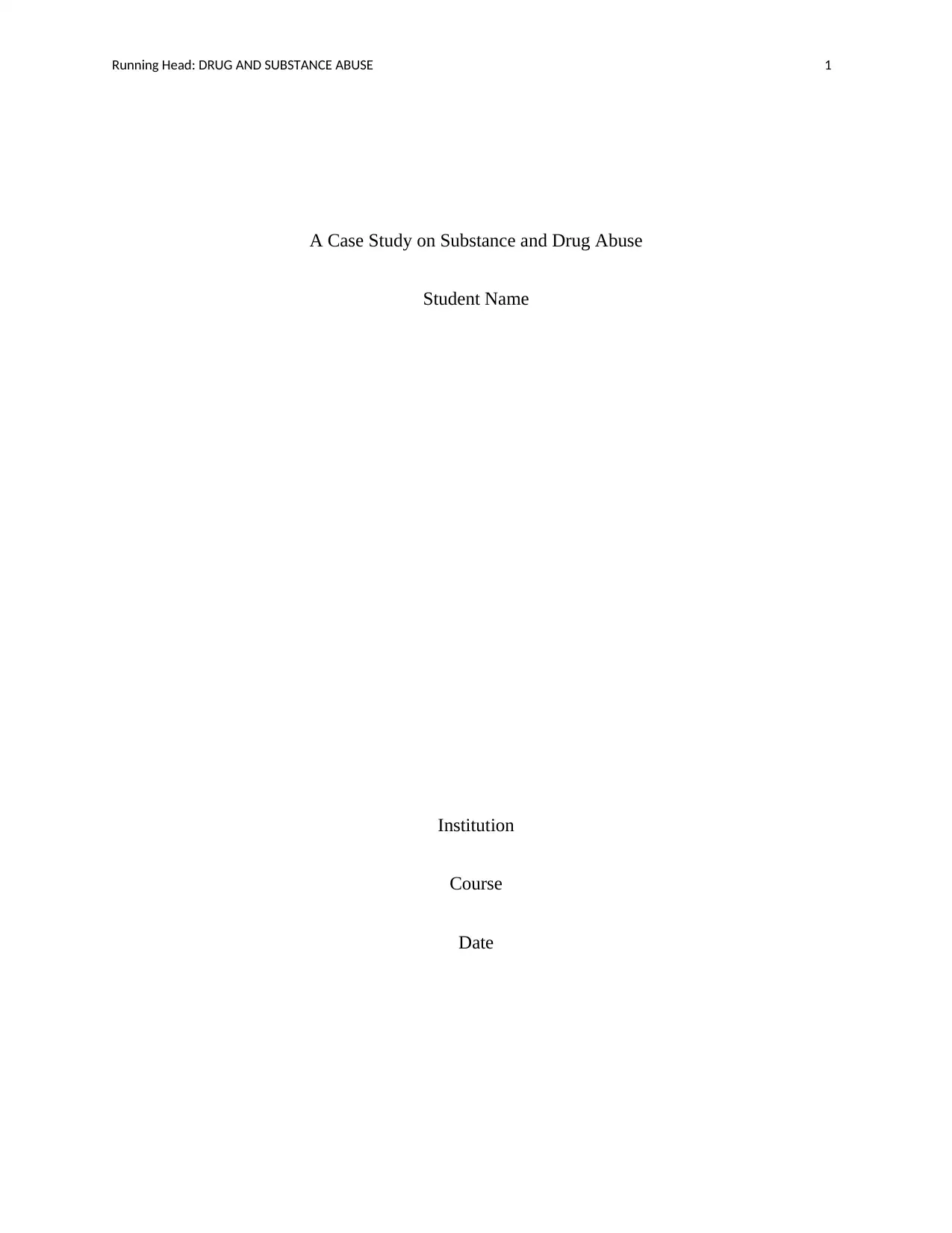
Running Head: DRUG AND SUBSTANCE ABUSE 1
A Case Study on Substance and Drug Abuse
Student Name
Institution
Course
Date
A Case Study on Substance and Drug Abuse
Student Name
Institution
Course
Date
Paraphrase This Document
Need a fresh take? Get an instant paraphrase of this document with our AI Paraphraser
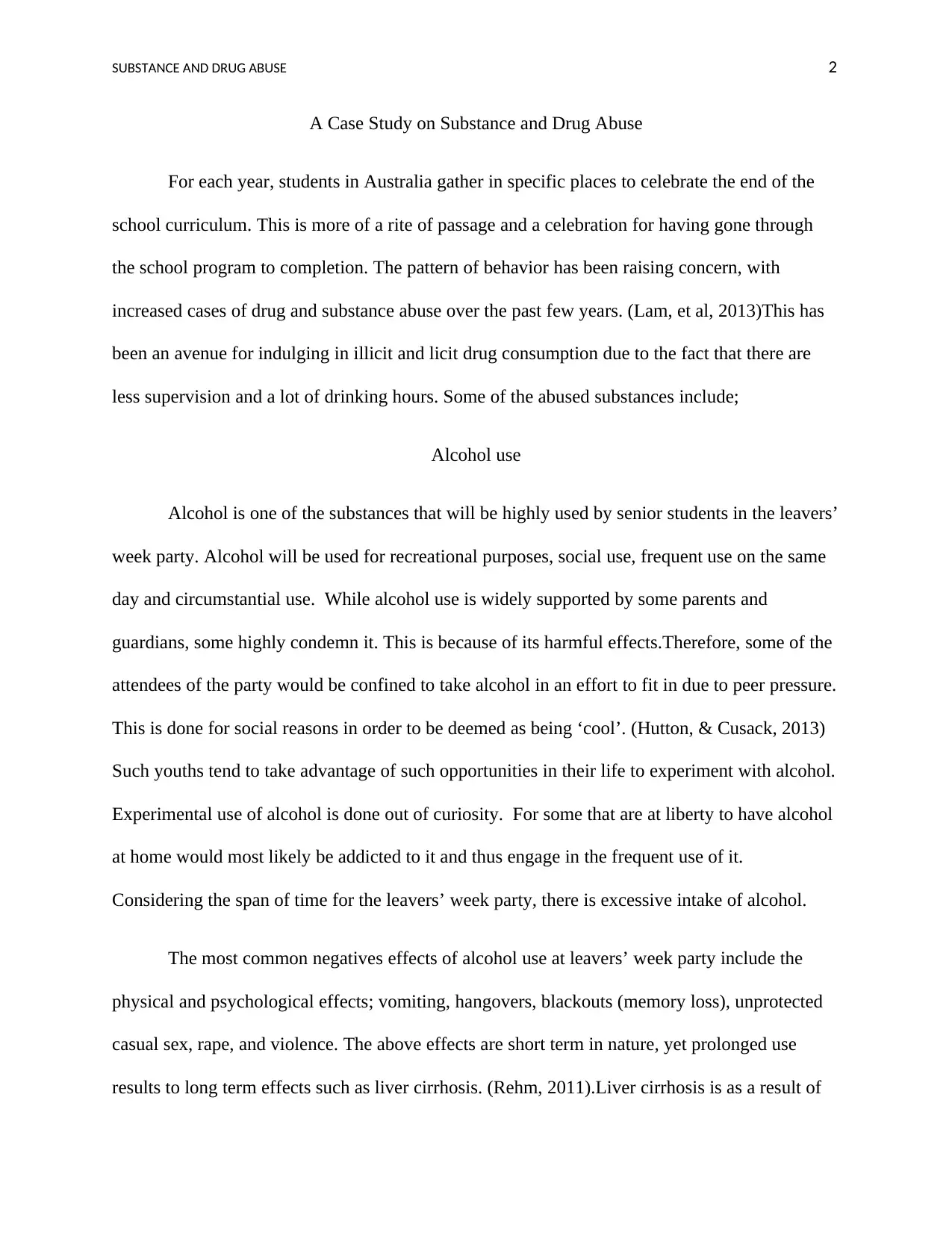
SUBSTANCE AND DRUG ABUSE 2
A Case Study on Substance and Drug Abuse
For each year, students in Australia gather in specific places to celebrate the end of the
school curriculum. This is more of a rite of passage and a celebration for having gone through
the school program to completion. The pattern of behavior has been raising concern, with
increased cases of drug and substance abuse over the past few years. (Lam, et al, 2013)This has
been an avenue for indulging in illicit and licit drug consumption due to the fact that there are
less supervision and a lot of drinking hours. Some of the abused substances include;
Alcohol use
Alcohol is one of the substances that will be highly used by senior students in the leavers’
week party. Alcohol will be used for recreational purposes, social use, frequent use on the same
day and circumstantial use. While alcohol use is widely supported by some parents and
guardians, some highly condemn it. This is because of its harmful effects.Therefore, some of the
attendees of the party would be confined to take alcohol in an effort to fit in due to peer pressure.
This is done for social reasons in order to be deemed as being ‘cool’. (Hutton, & Cusack, 2013)
Such youths tend to take advantage of such opportunities in their life to experiment with alcohol.
Experimental use of alcohol is done out of curiosity. For some that are at liberty to have alcohol
at home would most likely be addicted to it and thus engage in the frequent use of it.
Considering the span of time for the leavers’ week party, there is excessive intake of alcohol.
The most common negatives effects of alcohol use at leavers’ week party include the
physical and psychological effects; vomiting, hangovers, blackouts (memory loss), unprotected
casual sex, rape, and violence. The above effects are short term in nature, yet prolonged use
results to long term effects such as liver cirrhosis. (Rehm, 2011).Liver cirrhosis is as a result of
A Case Study on Substance and Drug Abuse
For each year, students in Australia gather in specific places to celebrate the end of the
school curriculum. This is more of a rite of passage and a celebration for having gone through
the school program to completion. The pattern of behavior has been raising concern, with
increased cases of drug and substance abuse over the past few years. (Lam, et al, 2013)This has
been an avenue for indulging in illicit and licit drug consumption due to the fact that there are
less supervision and a lot of drinking hours. Some of the abused substances include;
Alcohol use
Alcohol is one of the substances that will be highly used by senior students in the leavers’
week party. Alcohol will be used for recreational purposes, social use, frequent use on the same
day and circumstantial use. While alcohol use is widely supported by some parents and
guardians, some highly condemn it. This is because of its harmful effects.Therefore, some of the
attendees of the party would be confined to take alcohol in an effort to fit in due to peer pressure.
This is done for social reasons in order to be deemed as being ‘cool’. (Hutton, & Cusack, 2013)
Such youths tend to take advantage of such opportunities in their life to experiment with alcohol.
Experimental use of alcohol is done out of curiosity. For some that are at liberty to have alcohol
at home would most likely be addicted to it and thus engage in the frequent use of it.
Considering the span of time for the leavers’ week party, there is excessive intake of alcohol.
The most common negatives effects of alcohol use at leavers’ week party include the
physical and psychological effects; vomiting, hangovers, blackouts (memory loss), unprotected
casual sex, rape, and violence. The above effects are short term in nature, yet prolonged use
results to long term effects such as liver cirrhosis. (Rehm, 2011).Liver cirrhosis is as a result of

SUBSTANCE AND DRUG ABUSE 3
inflammation of the liver due to persistent and excessive intake of harmful substance into the
body. The short term effects are interconnected. Blackouts may lead to unprotected casual sex.
Unprotected sex contracts sexually transmitted diseases (STDs). Rape cases have increased,
unfortunately, the rape victims are left depressed and in a state of memory loss. Blackouts make
it difficult for justice to be executed. Cases of violence are not uncommon. This leads to severe
injuries and unfortunately, innocent people become casualties of violence by bullies. The
Western Authorities are highly committed to ensuring that such offenders are not left to go
unpunished.
The use of Cannabis
A large proportion of the youths who attend the school leavers’ celebratory event engage
in illicit use of Cannabis. Most of the youths that attend are in their adolescent stage of life which
is characterized by restlessness, search for self, need for a much activity due to increased energy
and so forth. Cannabis is the most widely used illicit drug substance in Western Australia. It has
its subspecies as Cannabis Sativa and Cannabis Indica. (Freeman, & Winstock, 2015)It is
normally taken in several forms.
In the form of herbal Cannabis also called Marijuana, this is made by drying the leaves
and flowers of the plant. It is considered as the most subtle form of cannabis. (Winstock, &
Barratt, 2013) Cannabis can take the form of hashish which is the dried resin of the cannabis
plant. The last form which has the strongest effects of them all is hashish oil. It is extracted from
resin and can be used in food. The effects of Cannabis are quite severe. It is a depressant of the
Central Nervous System and alters the perception of the sensory nerves. It produces health
effects of hallucinations, inaccurate judgment including time distortion, panic and paranoia,
inflammation of the liver due to persistent and excessive intake of harmful substance into the
body. The short term effects are interconnected. Blackouts may lead to unprotected casual sex.
Unprotected sex contracts sexually transmitted diseases (STDs). Rape cases have increased,
unfortunately, the rape victims are left depressed and in a state of memory loss. Blackouts make
it difficult for justice to be executed. Cases of violence are not uncommon. This leads to severe
injuries and unfortunately, innocent people become casualties of violence by bullies. The
Western Authorities are highly committed to ensuring that such offenders are not left to go
unpunished.
The use of Cannabis
A large proportion of the youths who attend the school leavers’ celebratory event engage
in illicit use of Cannabis. Most of the youths that attend are in their adolescent stage of life which
is characterized by restlessness, search for self, need for a much activity due to increased energy
and so forth. Cannabis is the most widely used illicit drug substance in Western Australia. It has
its subspecies as Cannabis Sativa and Cannabis Indica. (Freeman, & Winstock, 2015)It is
normally taken in several forms.
In the form of herbal Cannabis also called Marijuana, this is made by drying the leaves
and flowers of the plant. It is considered as the most subtle form of cannabis. (Winstock, &
Barratt, 2013) Cannabis can take the form of hashish which is the dried resin of the cannabis
plant. The last form which has the strongest effects of them all is hashish oil. It is extracted from
resin and can be used in food. The effects of Cannabis are quite severe. It is a depressant of the
Central Nervous System and alters the perception of the sensory nerves. It produces health
effects of hallucinations, inaccurate judgment including time distortion, panic and paranoia,
⊘ This is a preview!⊘
Do you want full access?
Subscribe today to unlock all pages.

Trusted by 1+ million students worldwide
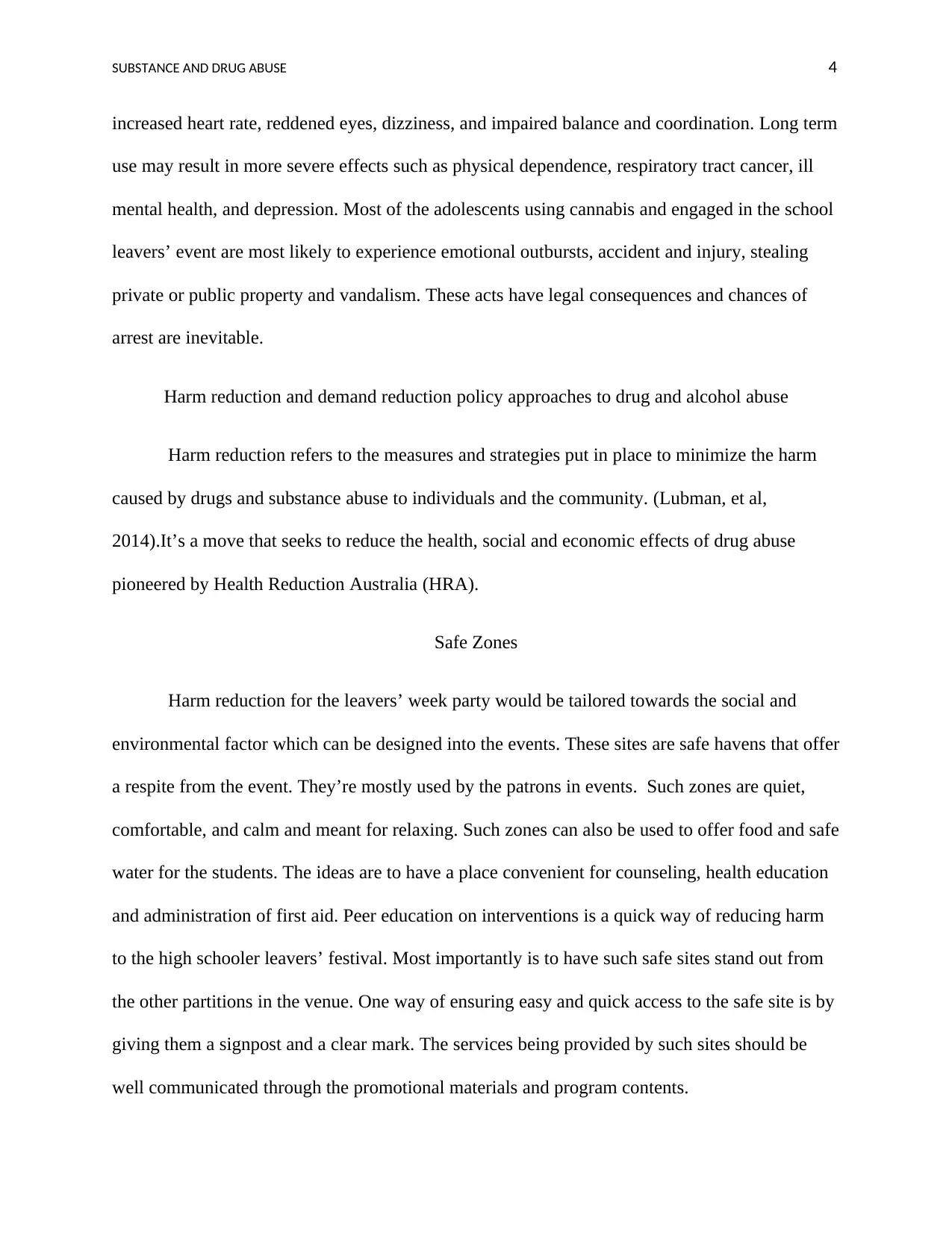
SUBSTANCE AND DRUG ABUSE 4
increased heart rate, reddened eyes, dizziness, and impaired balance and coordination. Long term
use may result in more severe effects such as physical dependence, respiratory tract cancer, ill
mental health, and depression. Most of the adolescents using cannabis and engaged in the school
leavers’ event are most likely to experience emotional outbursts, accident and injury, stealing
private or public property and vandalism. These acts have legal consequences and chances of
arrest are inevitable.
Harm reduction and demand reduction policy approaches to drug and alcohol abuse
Harm reduction refers to the measures and strategies put in place to minimize the harm
caused by drugs and substance abuse to individuals and the community. (Lubman, et al,
2014).It’s a move that seeks to reduce the health, social and economic effects of drug abuse
pioneered by Health Reduction Australia (HRA).
Safe Zones
Harm reduction for the leavers’ week party would be tailored towards the social and
environmental factor which can be designed into the events. These sites are safe havens that offer
a respite from the event. They’re mostly used by the patrons in events. Such zones are quiet,
comfortable, and calm and meant for relaxing. Such zones can also be used to offer food and safe
water for the students. The ideas are to have a place convenient for counseling, health education
and administration of first aid. Peer education on interventions is a quick way of reducing harm
to the high schooler leavers’ festival. Most importantly is to have such safe sites stand out from
the other partitions in the venue. One way of ensuring easy and quick access to the safe site is by
giving them a signpost and a clear mark. The services being provided by such sites should be
well communicated through the promotional materials and program contents.
increased heart rate, reddened eyes, dizziness, and impaired balance and coordination. Long term
use may result in more severe effects such as physical dependence, respiratory tract cancer, ill
mental health, and depression. Most of the adolescents using cannabis and engaged in the school
leavers’ event are most likely to experience emotional outbursts, accident and injury, stealing
private or public property and vandalism. These acts have legal consequences and chances of
arrest are inevitable.
Harm reduction and demand reduction policy approaches to drug and alcohol abuse
Harm reduction refers to the measures and strategies put in place to minimize the harm
caused by drugs and substance abuse to individuals and the community. (Lubman, et al,
2014).It’s a move that seeks to reduce the health, social and economic effects of drug abuse
pioneered by Health Reduction Australia (HRA).
Safe Zones
Harm reduction for the leavers’ week party would be tailored towards the social and
environmental factor which can be designed into the events. These sites are safe havens that offer
a respite from the event. They’re mostly used by the patrons in events. Such zones are quiet,
comfortable, and calm and meant for relaxing. Such zones can also be used to offer food and safe
water for the students. The ideas are to have a place convenient for counseling, health education
and administration of first aid. Peer education on interventions is a quick way of reducing harm
to the high schooler leavers’ festival. Most importantly is to have such safe sites stand out from
the other partitions in the venue. One way of ensuring easy and quick access to the safe site is by
giving them a signpost and a clear mark. The services being provided by such sites should be
well communicated through the promotional materials and program contents.
Paraphrase This Document
Need a fresh take? Get an instant paraphrase of this document with our AI Paraphraser
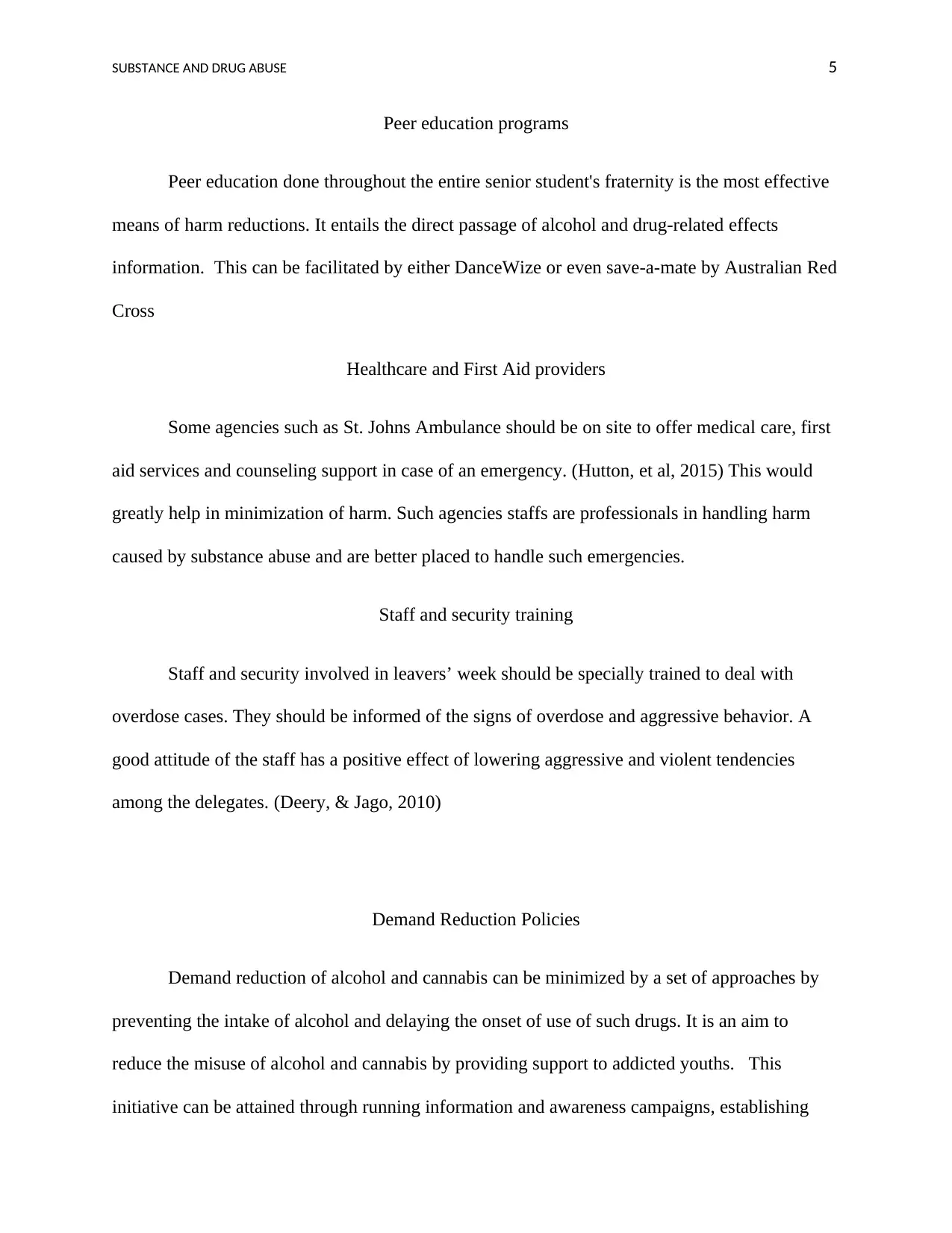
SUBSTANCE AND DRUG ABUSE 5
Peer education programs
Peer education done throughout the entire senior student's fraternity is the most effective
means of harm reductions. It entails the direct passage of alcohol and drug-related effects
information. This can be facilitated by either DanceWize or even save-a-mate by Australian Red
Cross
Healthcare and First Aid providers
Some agencies such as St. Johns Ambulance should be on site to offer medical care, first
aid services and counseling support in case of an emergency. (Hutton, et al, 2015) This would
greatly help in minimization of harm. Such agencies staffs are professionals in handling harm
caused by substance abuse and are better placed to handle such emergencies.
Staff and security training
Staff and security involved in leavers’ week should be specially trained to deal with
overdose cases. They should be informed of the signs of overdose and aggressive behavior. A
good attitude of the staff has a positive effect of lowering aggressive and violent tendencies
among the delegates. (Deery, & Jago, 2010)
Demand Reduction Policies
Demand reduction of alcohol and cannabis can be minimized by a set of approaches by
preventing the intake of alcohol and delaying the onset of use of such drugs. It is an aim to
reduce the misuse of alcohol and cannabis by providing support to addicted youths. This
initiative can be attained through running information and awareness campaigns, establishing
Peer education programs
Peer education done throughout the entire senior student's fraternity is the most effective
means of harm reductions. It entails the direct passage of alcohol and drug-related effects
information. This can be facilitated by either DanceWize or even save-a-mate by Australian Red
Cross
Healthcare and First Aid providers
Some agencies such as St. Johns Ambulance should be on site to offer medical care, first
aid services and counseling support in case of an emergency. (Hutton, et al, 2015) This would
greatly help in minimization of harm. Such agencies staffs are professionals in handling harm
caused by substance abuse and are better placed to handle such emergencies.
Staff and security training
Staff and security involved in leavers’ week should be specially trained to deal with
overdose cases. They should be informed of the signs of overdose and aggressive behavior. A
good attitude of the staff has a positive effect of lowering aggressive and violent tendencies
among the delegates. (Deery, & Jago, 2010)
Demand Reduction Policies
Demand reduction of alcohol and cannabis can be minimized by a set of approaches by
preventing the intake of alcohol and delaying the onset of use of such drugs. It is an aim to
reduce the misuse of alcohol and cannabis by providing support to addicted youths. This
initiative can be attained through running information and awareness campaigns, establishing
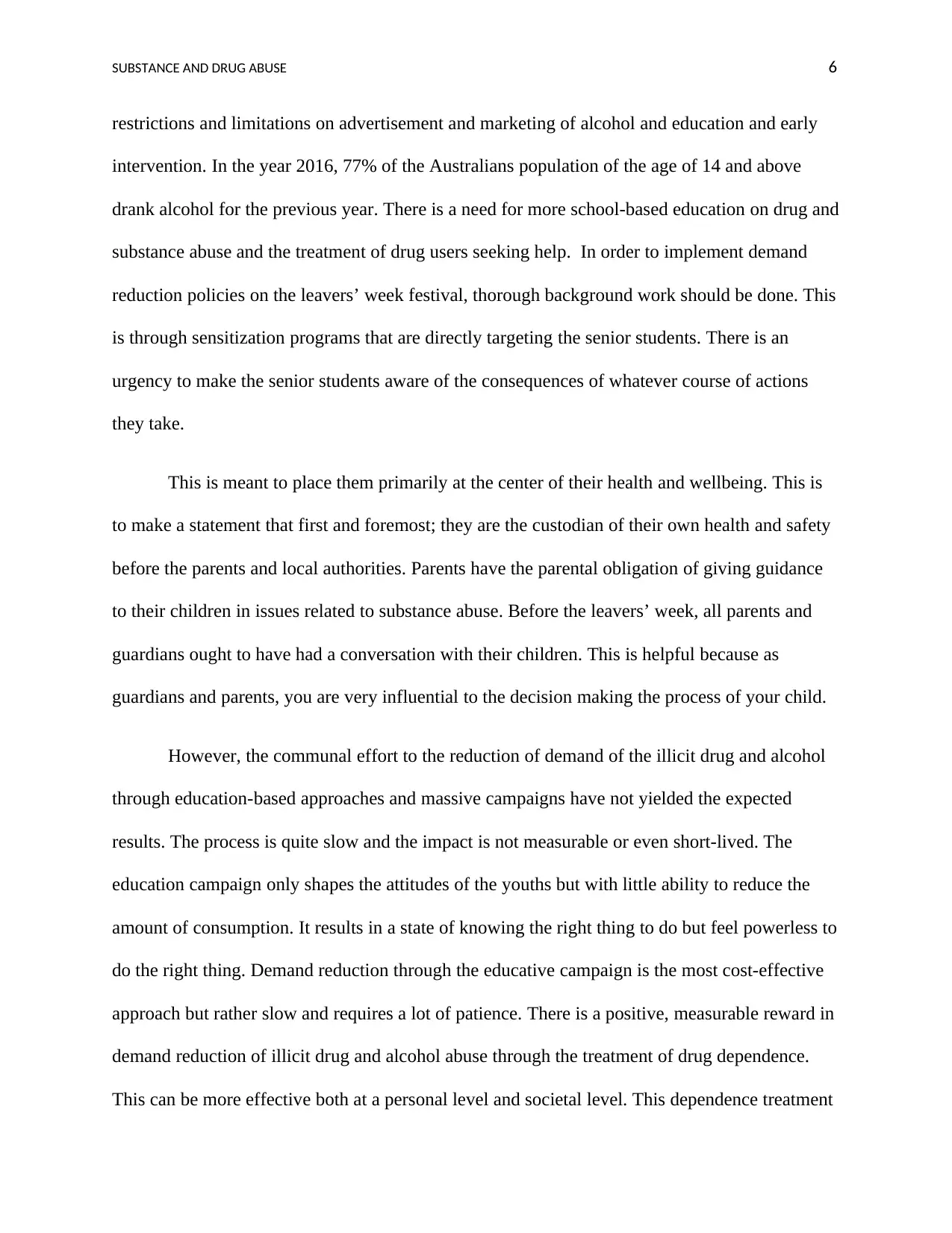
SUBSTANCE AND DRUG ABUSE 6
restrictions and limitations on advertisement and marketing of alcohol and education and early
intervention. In the year 2016, 77% of the Australians population of the age of 14 and above
drank alcohol for the previous year. There is a need for more school-based education on drug and
substance abuse and the treatment of drug users seeking help. In order to implement demand
reduction policies on the leavers’ week festival, thorough background work should be done. This
is through sensitization programs that are directly targeting the senior students. There is an
urgency to make the senior students aware of the consequences of whatever course of actions
they take.
This is meant to place them primarily at the center of their health and wellbeing. This is
to make a statement that first and foremost; they are the custodian of their own health and safety
before the parents and local authorities. Parents have the parental obligation of giving guidance
to their children in issues related to substance abuse. Before the leavers’ week, all parents and
guardians ought to have had a conversation with their children. This is helpful because as
guardians and parents, you are very influential to the decision making the process of your child.
However, the communal effort to the reduction of demand of the illicit drug and alcohol
through education-based approaches and massive campaigns have not yielded the expected
results. The process is quite slow and the impact is not measurable or even short-lived. The
education campaign only shapes the attitudes of the youths but with little ability to reduce the
amount of consumption. It results in a state of knowing the right thing to do but feel powerless to
do the right thing. Demand reduction through the educative campaign is the most cost-effective
approach but rather slow and requires a lot of patience. There is a positive, measurable reward in
demand reduction of illicit drug and alcohol abuse through the treatment of drug dependence.
This can be more effective both at a personal level and societal level. This dependence treatment
restrictions and limitations on advertisement and marketing of alcohol and education and early
intervention. In the year 2016, 77% of the Australians population of the age of 14 and above
drank alcohol for the previous year. There is a need for more school-based education on drug and
substance abuse and the treatment of drug users seeking help. In order to implement demand
reduction policies on the leavers’ week festival, thorough background work should be done. This
is through sensitization programs that are directly targeting the senior students. There is an
urgency to make the senior students aware of the consequences of whatever course of actions
they take.
This is meant to place them primarily at the center of their health and wellbeing. This is
to make a statement that first and foremost; they are the custodian of their own health and safety
before the parents and local authorities. Parents have the parental obligation of giving guidance
to their children in issues related to substance abuse. Before the leavers’ week, all parents and
guardians ought to have had a conversation with their children. This is helpful because as
guardians and parents, you are very influential to the decision making the process of your child.
However, the communal effort to the reduction of demand of the illicit drug and alcohol
through education-based approaches and massive campaigns have not yielded the expected
results. The process is quite slow and the impact is not measurable or even short-lived. The
education campaign only shapes the attitudes of the youths but with little ability to reduce the
amount of consumption. It results in a state of knowing the right thing to do but feel powerless to
do the right thing. Demand reduction through the educative campaign is the most cost-effective
approach but rather slow and requires a lot of patience. There is a positive, measurable reward in
demand reduction of illicit drug and alcohol abuse through the treatment of drug dependence.
This can be more effective both at a personal level and societal level. This dependence treatment
⊘ This is a preview!⊘
Do you want full access?
Subscribe today to unlock all pages.

Trusted by 1+ million students worldwide
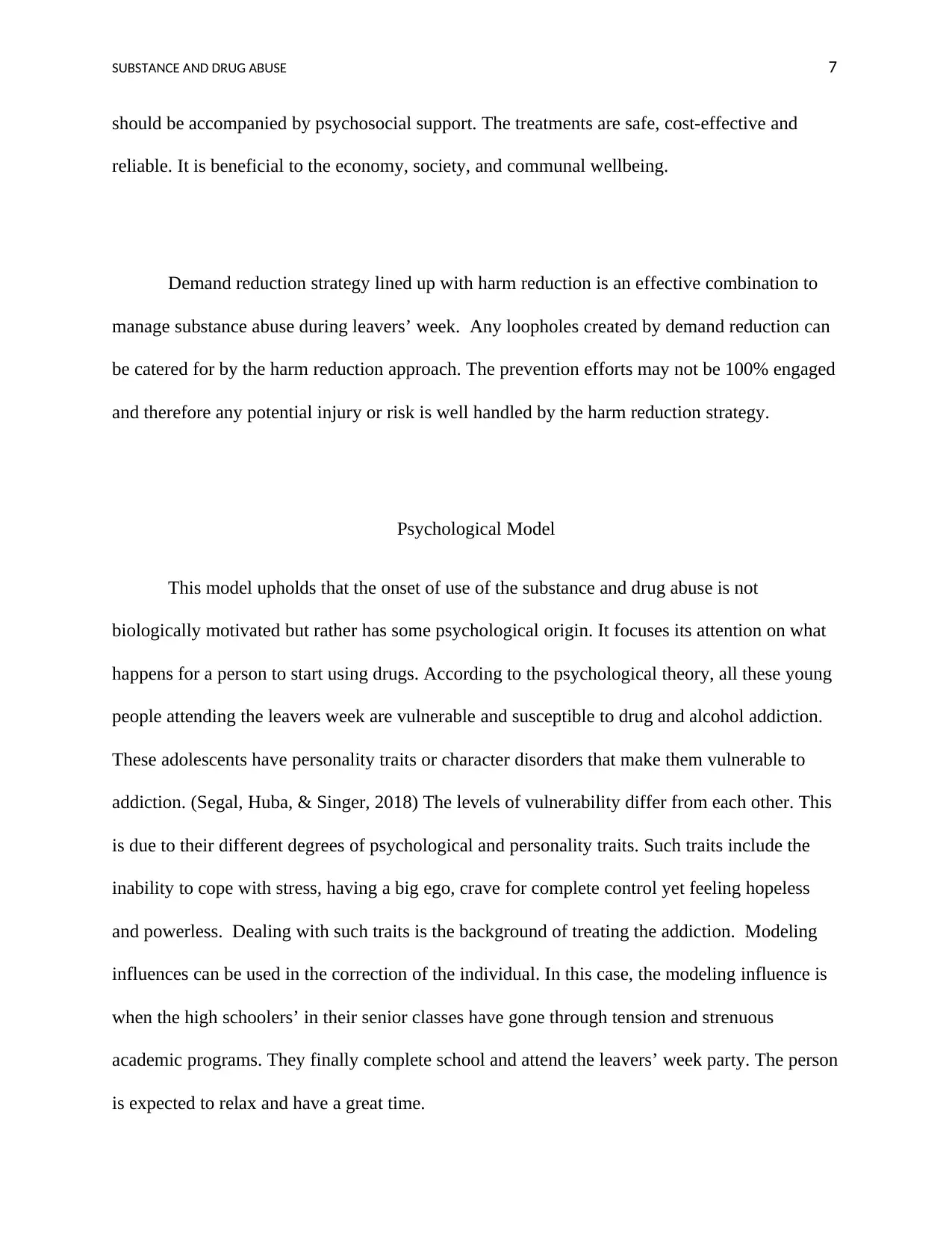
SUBSTANCE AND DRUG ABUSE 7
should be accompanied by psychosocial support. The treatments are safe, cost-effective and
reliable. It is beneficial to the economy, society, and communal wellbeing.
Demand reduction strategy lined up with harm reduction is an effective combination to
manage substance abuse during leavers’ week. Any loopholes created by demand reduction can
be catered for by the harm reduction approach. The prevention efforts may not be 100% engaged
and therefore any potential injury or risk is well handled by the harm reduction strategy.
Psychological Model
This model upholds that the onset of use of the substance and drug abuse is not
biologically motivated but rather has some psychological origin. It focuses its attention on what
happens for a person to start using drugs. According to the psychological theory, all these young
people attending the leavers week are vulnerable and susceptible to drug and alcohol addiction.
These adolescents have personality traits or character disorders that make them vulnerable to
addiction. (Segal, Huba, & Singer, 2018) The levels of vulnerability differ from each other. This
is due to their different degrees of psychological and personality traits. Such traits include the
inability to cope with stress, having a big ego, crave for complete control yet feeling hopeless
and powerless. Dealing with such traits is the background of treating the addiction. Modeling
influences can be used in the correction of the individual. In this case, the modeling influence is
when the high schoolers’ in their senior classes have gone through tension and strenuous
academic programs. They finally complete school and attend the leavers’ week party. The person
is expected to relax and have a great time.
should be accompanied by psychosocial support. The treatments are safe, cost-effective and
reliable. It is beneficial to the economy, society, and communal wellbeing.
Demand reduction strategy lined up with harm reduction is an effective combination to
manage substance abuse during leavers’ week. Any loopholes created by demand reduction can
be catered for by the harm reduction approach. The prevention efforts may not be 100% engaged
and therefore any potential injury or risk is well handled by the harm reduction strategy.
Psychological Model
This model upholds that the onset of use of the substance and drug abuse is not
biologically motivated but rather has some psychological origin. It focuses its attention on what
happens for a person to start using drugs. According to the psychological theory, all these young
people attending the leavers week are vulnerable and susceptible to drug and alcohol addiction.
These adolescents have personality traits or character disorders that make them vulnerable to
addiction. (Segal, Huba, & Singer, 2018) The levels of vulnerability differ from each other. This
is due to their different degrees of psychological and personality traits. Such traits include the
inability to cope with stress, having a big ego, crave for complete control yet feeling hopeless
and powerless. Dealing with such traits is the background of treating the addiction. Modeling
influences can be used in the correction of the individual. In this case, the modeling influence is
when the high schoolers’ in their senior classes have gone through tension and strenuous
academic programs. They finally complete school and attend the leavers’ week party. The person
is expected to relax and have a great time.
Paraphrase This Document
Need a fresh take? Get an instant paraphrase of this document with our AI Paraphraser
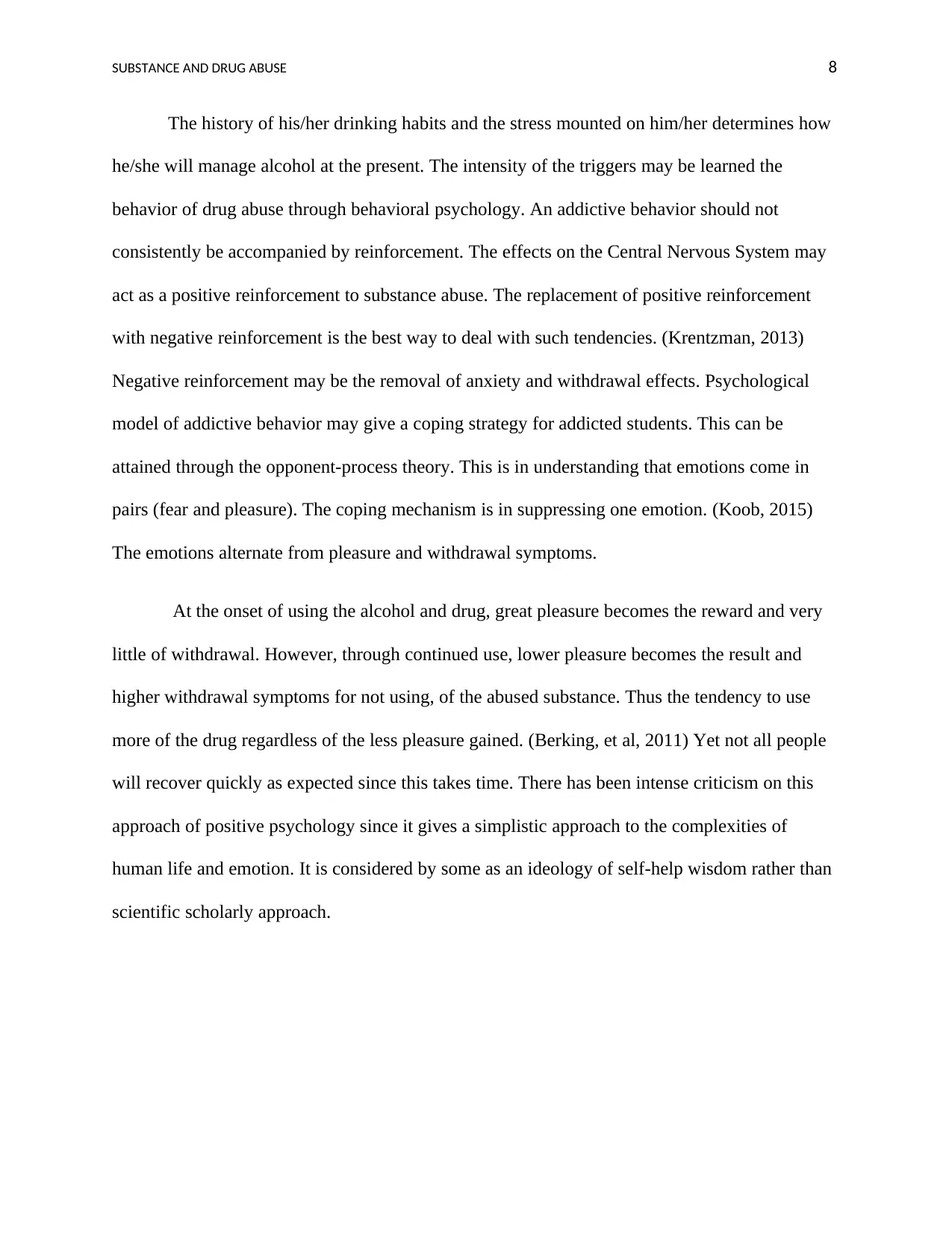
SUBSTANCE AND DRUG ABUSE 8
The history of his/her drinking habits and the stress mounted on him/her determines how
he/she will manage alcohol at the present. The intensity of the triggers may be learned the
behavior of drug abuse through behavioral psychology. An addictive behavior should not
consistently be accompanied by reinforcement. The effects on the Central Nervous System may
act as a positive reinforcement to substance abuse. The replacement of positive reinforcement
with negative reinforcement is the best way to deal with such tendencies. (Krentzman, 2013)
Negative reinforcement may be the removal of anxiety and withdrawal effects. Psychological
model of addictive behavior may give a coping strategy for addicted students. This can be
attained through the opponent-process theory. This is in understanding that emotions come in
pairs (fear and pleasure). The coping mechanism is in suppressing one emotion. (Koob, 2015)
The emotions alternate from pleasure and withdrawal symptoms.
At the onset of using the alcohol and drug, great pleasure becomes the reward and very
little of withdrawal. However, through continued use, lower pleasure becomes the result and
higher withdrawal symptoms for not using, of the abused substance. Thus the tendency to use
more of the drug regardless of the less pleasure gained. (Berking, et al, 2011) Yet not all people
will recover quickly as expected since this takes time. There has been intense criticism on this
approach of positive psychology since it gives a simplistic approach to the complexities of
human life and emotion. It is considered by some as an ideology of self-help wisdom rather than
scientific scholarly approach.
The history of his/her drinking habits and the stress mounted on him/her determines how
he/she will manage alcohol at the present. The intensity of the triggers may be learned the
behavior of drug abuse through behavioral psychology. An addictive behavior should not
consistently be accompanied by reinforcement. The effects on the Central Nervous System may
act as a positive reinforcement to substance abuse. The replacement of positive reinforcement
with negative reinforcement is the best way to deal with such tendencies. (Krentzman, 2013)
Negative reinforcement may be the removal of anxiety and withdrawal effects. Psychological
model of addictive behavior may give a coping strategy for addicted students. This can be
attained through the opponent-process theory. This is in understanding that emotions come in
pairs (fear and pleasure). The coping mechanism is in suppressing one emotion. (Koob, 2015)
The emotions alternate from pleasure and withdrawal symptoms.
At the onset of using the alcohol and drug, great pleasure becomes the reward and very
little of withdrawal. However, through continued use, lower pleasure becomes the result and
higher withdrawal symptoms for not using, of the abused substance. Thus the tendency to use
more of the drug regardless of the less pleasure gained. (Berking, et al, 2011) Yet not all people
will recover quickly as expected since this takes time. There has been intense criticism on this
approach of positive psychology since it gives a simplistic approach to the complexities of
human life and emotion. It is considered by some as an ideology of self-help wisdom rather than
scientific scholarly approach.
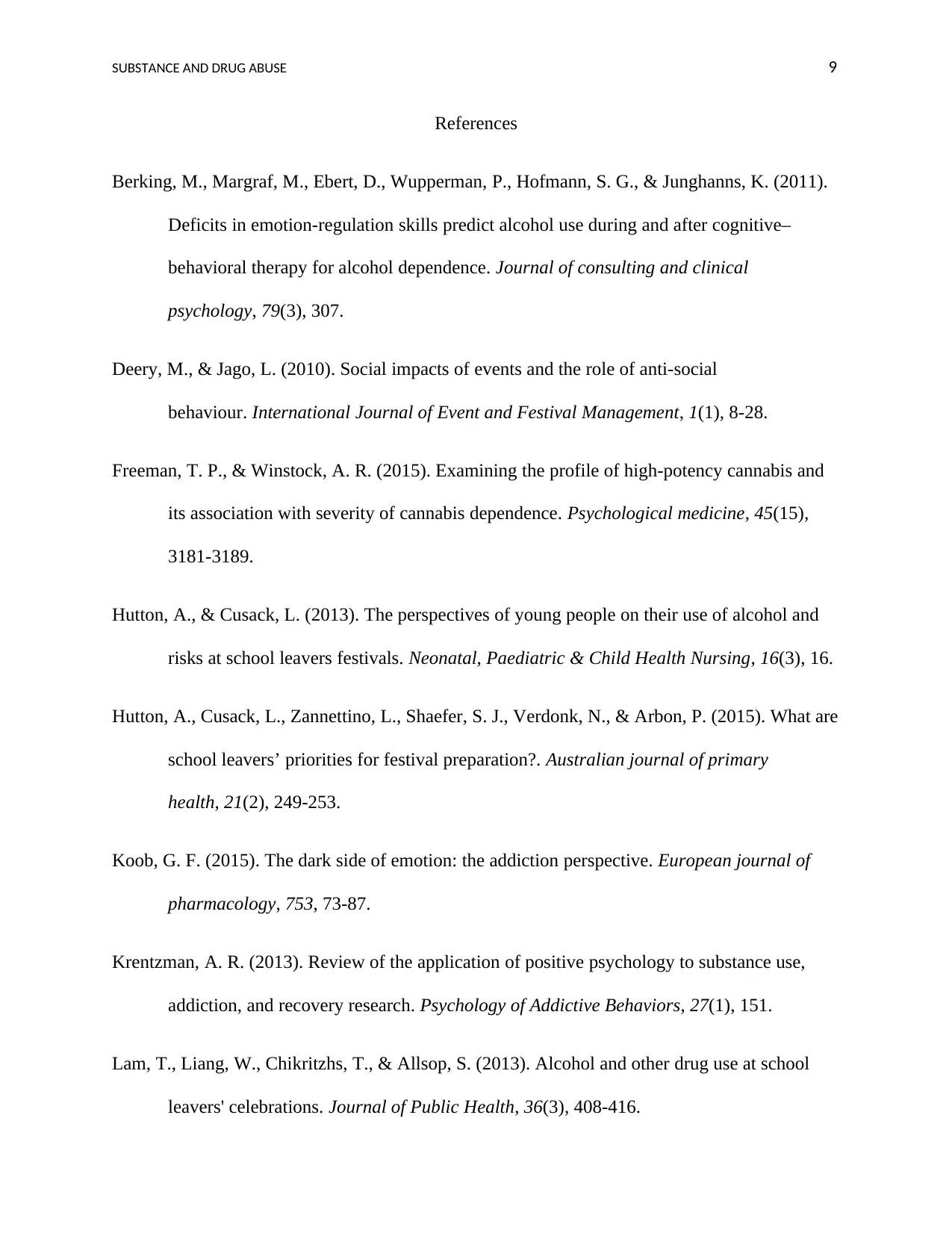
SUBSTANCE AND DRUG ABUSE 9
References
Berking, M., Margraf, M., Ebert, D., Wupperman, P., Hofmann, S. G., & Junghanns, K. (2011).
Deficits in emotion-regulation skills predict alcohol use during and after cognitive–
behavioral therapy for alcohol dependence. Journal of consulting and clinical
psychology, 79(3), 307.
Deery, M., & Jago, L. (2010). Social impacts of events and the role of anti-social
behaviour. International Journal of Event and Festival Management, 1(1), 8-28.
Freeman, T. P., & Winstock, A. R. (2015). Examining the profile of high-potency cannabis and
its association with severity of cannabis dependence. Psychological medicine, 45(15),
3181-3189.
Hutton, A., & Cusack, L. (2013). The perspectives of young people on their use of alcohol and
risks at school leavers festivals. Neonatal, Paediatric & Child Health Nursing, 16(3), 16.
Hutton, A., Cusack, L., Zannettino, L., Shaefer, S. J., Verdonk, N., & Arbon, P. (2015). What are
school leavers’ priorities for festival preparation?. Australian journal of primary
health, 21(2), 249-253.
Koob, G. F. (2015). The dark side of emotion: the addiction perspective. European journal of
pharmacology, 753, 73-87.
Krentzman, A. R. (2013). Review of the application of positive psychology to substance use,
addiction, and recovery research. Psychology of Addictive Behaviors, 27(1), 151.
Lam, T., Liang, W., Chikritzhs, T., & Allsop, S. (2013). Alcohol and other drug use at school
leavers' celebrations. Journal of Public Health, 36(3), 408-416.
References
Berking, M., Margraf, M., Ebert, D., Wupperman, P., Hofmann, S. G., & Junghanns, K. (2011).
Deficits in emotion-regulation skills predict alcohol use during and after cognitive–
behavioral therapy for alcohol dependence. Journal of consulting and clinical
psychology, 79(3), 307.
Deery, M., & Jago, L. (2010). Social impacts of events and the role of anti-social
behaviour. International Journal of Event and Festival Management, 1(1), 8-28.
Freeman, T. P., & Winstock, A. R. (2015). Examining the profile of high-potency cannabis and
its association with severity of cannabis dependence. Psychological medicine, 45(15),
3181-3189.
Hutton, A., & Cusack, L. (2013). The perspectives of young people on their use of alcohol and
risks at school leavers festivals. Neonatal, Paediatric & Child Health Nursing, 16(3), 16.
Hutton, A., Cusack, L., Zannettino, L., Shaefer, S. J., Verdonk, N., & Arbon, P. (2015). What are
school leavers’ priorities for festival preparation?. Australian journal of primary
health, 21(2), 249-253.
Koob, G. F. (2015). The dark side of emotion: the addiction perspective. European journal of
pharmacology, 753, 73-87.
Krentzman, A. R. (2013). Review of the application of positive psychology to substance use,
addiction, and recovery research. Psychology of Addictive Behaviors, 27(1), 151.
Lam, T., Liang, W., Chikritzhs, T., & Allsop, S. (2013). Alcohol and other drug use at school
leavers' celebrations. Journal of Public Health, 36(3), 408-416.
⊘ This is a preview!⊘
Do you want full access?
Subscribe today to unlock all pages.

Trusted by 1+ million students worldwide
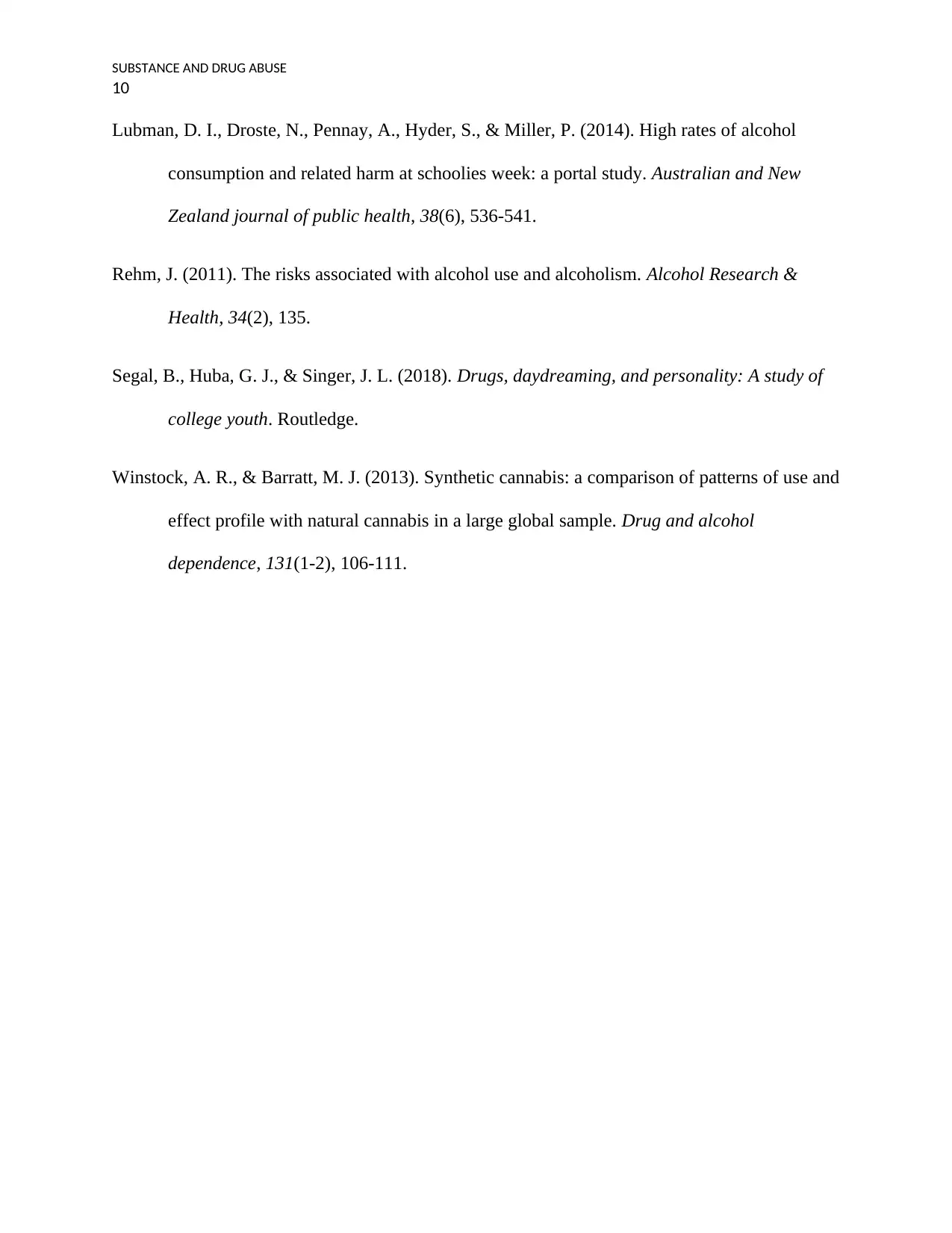
SUBSTANCE AND DRUG ABUSE
10
Lubman, D. I., Droste, N., Pennay, A., Hyder, S., & Miller, P. (2014). High rates of alcohol
consumption and related harm at schoolies week: a portal study. Australian and New
Zealand journal of public health, 38(6), 536-541.
Rehm, J. (2011). The risks associated with alcohol use and alcoholism. Alcohol Research &
Health, 34(2), 135.
Segal, B., Huba, G. J., & Singer, J. L. (2018). Drugs, daydreaming, and personality: A study of
college youth. Routledge.
Winstock, A. R., & Barratt, M. J. (2013). Synthetic cannabis: a comparison of patterns of use and
effect profile with natural cannabis in a large global sample. Drug and alcohol
dependence, 131(1-2), 106-111.
10
Lubman, D. I., Droste, N., Pennay, A., Hyder, S., & Miller, P. (2014). High rates of alcohol
consumption and related harm at schoolies week: a portal study. Australian and New
Zealand journal of public health, 38(6), 536-541.
Rehm, J. (2011). The risks associated with alcohol use and alcoholism. Alcohol Research &
Health, 34(2), 135.
Segal, B., Huba, G. J., & Singer, J. L. (2018). Drugs, daydreaming, and personality: A study of
college youth. Routledge.
Winstock, A. R., & Barratt, M. J. (2013). Synthetic cannabis: a comparison of patterns of use and
effect profile with natural cannabis in a large global sample. Drug and alcohol
dependence, 131(1-2), 106-111.
Paraphrase This Document
Need a fresh take? Get an instant paraphrase of this document with our AI Paraphraser

SUBSTANCE AND DRUG ABUSE
11
11
1 out of 11
Your All-in-One AI-Powered Toolkit for Academic Success.
+13062052269
info@desklib.com
Available 24*7 on WhatsApp / Email
![[object Object]](/_next/static/media/star-bottom.7253800d.svg)
Unlock your academic potential
Copyright © 2020–2025 A2Z Services. All Rights Reserved. Developed and managed by ZUCOL.